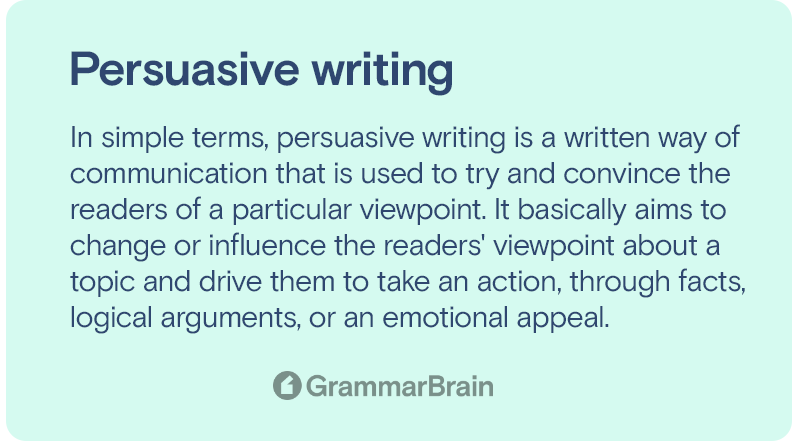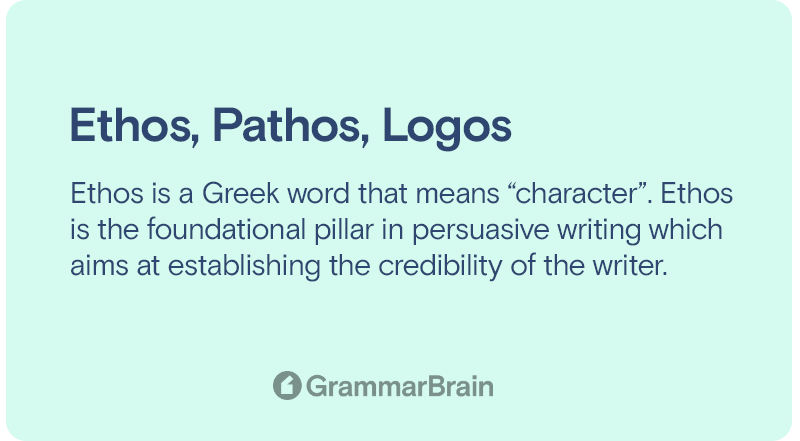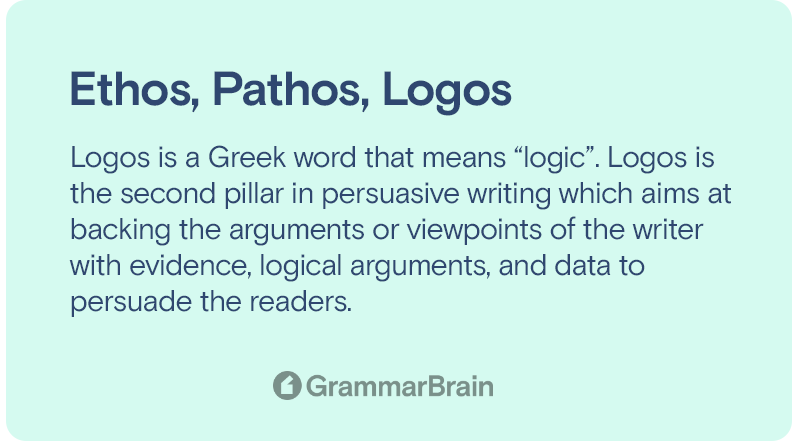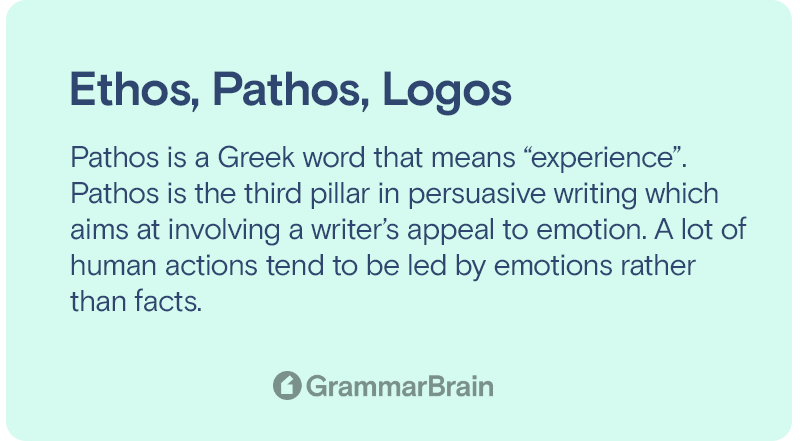Persuasive writing is a type of non-fiction writing that has the aim of spreading information while persuading the reader of the writer’s stance or point of view. Persuasive writing has been used in the English language for years. It can easily be found in reviews, advertisements, marketing copies, etc.
This article will detail the basics of persuasive writing, its importance, core components, and tips for effective persuasive writing.

What exactly is persuasive writing?
In simple terms, persuasive writing is a written way of communication that is used to try and convince the readers of a particular viewpoint. It basically aims to change or influence the readers’ viewpoint about a topic and drive them to take an action, through facts, logical arguments, or an emotional appeal.
Wikipedia defines persuasive writing as – “any written communication with the intention to convince or influence readers to believe in an idea/ opinion and to do an action.”
The very fact that persuasive writing is not just about spreading information, but about persuading the reader enables it to have a different set of techniques and strategies to effectively convince the reader.
What is the importance or real-life applications of persuasive writing?
Persuasive writing has lots of real-life applications, some of which are as follows:
- In a company blog article to convince the reader to buy a company product or service
- In a research proposal or a technical paper to convince the readers of the findings and deductions
- In a review article of food, a book, or a movie
- In a cover letter of a job applicant
- In an advertising campaign script to create a sense of urgency and convince the audience to buy a product or service. Advertising or marketing forms one of the biggest use cases for persuasive writing.
- In a political speech script to convince the audience of the leader’s opinion. Persuasive writing is heavily utilized in political speeches.
Ethos, Logos, and Pathos- the three pillars of persuasive writing
An effective piece of persuasive writing utilizes three fundamental features viz. ethos, logos, and pathos. These three features are to be strategically embedded at the core of any piece of persuasive writing to enhance it.
Let’s have a quick look at each of them and understand their significance:

1. Ethos
Ethos is a Greek word that means “character”. Ethos is the foundational pillar in persuasive writing which aims at establishing the credibility of the writer.
To convince any reader of any written piece of content, the first step is to make them believe the writer, and ethos achieves exactly that. Ethos helps establish a positive mindset in the minds of the readers, even before they start reading the written piece.

2. Logos
Logos is a Greek word that means “logic”. Logos is the second pillar in persuasive writing which aims at backing the arguments or viewpoints of the writer with evidence, logical arguments, and data to persuade the readers.
Any form of written content or argument becomes more persuasive when it is backed by facts and data. Backing their work with relevant facts expresses that the writer did a lot of research and has a very good idea of what they are talking about.
But merely having the facts and data is not enough. This is because if presented in a haphazard way, it will not be effective in capturing the reader’s attention. Thus, logos also deals with structuring the persuasive writing piece in the best possible manner to present them in the most effective manner.

2. Pathos
Pathos is a Greek word that means “experience”. Pathos is the third pillar in persuasive writing which aims at involving a writer’s appeal to emotion. A lot of human actions tend to be led by emotions rather than facts.
Hence, it is important for the readers to sympathize or empathize with the writer in order to be convinced of their viewpoint. These emotions can be engrained in the reader through the personal experiences of the writer.
Effective storytelling helps achieve a significant persuading impact. However, it is important for the writer to reflect on the various feelings that the readers might have while sharing this, as every person thinks differently.
What are some tips and strategies for effective persuasive writing?
Persuasive writing finds its applications in a wide variety of scenarios and, if effectively framed, can help achieve tremendous outcomes.
Here are some tips that writers can use for result-generating persuasive writing:
1. Choosing the right topic is important
It is crucial for writers to have deep knowledge about the topic for which the content is going to be written. Effective persuasive writing will involve a lot of subject knowledge, research, experiences, and passion for the topic. Only when a writer is absolutely clear about their own stance, will they be able to convince their readers.
2. Targeting the right audience and researching about them can do wonders
As much as possible, the writing should try to focus on a specialized set of reading audiences. This is because trying to cater to a broader audience will only dilute the impact of the content.
Writers must have a clear idea about their audience and what they want. In this way, they will be able to emotionally engage with them and deliver the message in a crisp and effective manner, inevitably persuading a larger number of readers.
3. The thesis statement should be defined appropriately
A clear and well-defined thesis statement is the heart and soul of any persuasive writing piece. Basically, it briefly summarizes the stance of the author (what the author wants to convince the audience). Clearly defining the thesis statement will help the author to appropriately structure the content around it.
4. Extensive research
A piece of persuasive writing content will involve a lot of logical arguments, facts, evidence, etc. Thus, writers must thoroughly research every piece of evidence or data that they plan to present to the readers. Even a glimpse of truthlessness might be a major turn-off for the reader.
5. Strategic repetition is important
It is important to remind the reader of the actual point of view that needs to be established and prevent them from getting swerve off the main topic. Hence, strategically repeating the main points in different ways in different places will keep the readers on track.
6. Address counter-arguments
One of the most interesting, but useful ways to convince the readers or increase the credibility of the content is by addressing the counter-arguments. This will strengthen the author’s original argument as contrasting viewpoints will be proved weaker.
7. Directly speaking to the readers is important
Merely targeting the right reading audience will not suffice. The audience needs to connect with the content and feel that this content is what they wanted to read.
Speaking directly to the reader will help achieve this in an impactful manner (for example referring to them as “you” and asking relevant questions at the right places).
8. Careful selection of words
Choosing the right words is one of the most important things in persuasive writing. Persuasive writing involves creating a bond with the reader through facts and emotions. It involves strong and emotive language (words that describe feelings).
Thus, any wrong choice of word or phrase might discourage the reader from forming a deep and impactful connection with the writer.
Ethos, Logos, and Pathos are at the core of every piece of persuasive writing. Complementing them with the strategies mentioned above will help create an extremely impactful piece of persuasive writing.
FAQs
1. What is the definition of persuasive writing?
Persuasive writing can be defined as a form of non-fiction writing that is used to convince the reader of the writer’s stance or point of view.
The writer provides their point of view and backs it up with research, evidence, and data. Along with this, they also try to emotionally appeal to the reader and convince them per that viewpoint or change their pre-existing viewpoint.
2. Where can persuasive writing be used?
Persuasive writing can be used in a variety of places like advertisements, brochures, editorials, proposals, reviews, political speeches, etc.
Advertising is one of the major areas where persuasive writing is heavily used to urge customers to buy the product or service of a company.
3. Why is persuasive writing important?
Persuasive writing is important because it finds a lot of real-life applications or scenarios. For example, it can be used in book reviews where the author tries to give an opinion about a book and back it up with their thoughts and opinions.
It can also be used in marketing campaigns or political speeches which has tremendous political or business impact. Hence, if persuasive writing is utilized effectively, it has the ability to create impactful changes in society or tremendous business or political outcomes.
4. What are the three types of persuasive writing?
Persuasive writing has three key components or types or pillars, namely ethos, logos, and pathos.
- Ethos: Credibility of the author
- Logos: Relevant logical arguments, evidence, data, and facts to back the viewpoint of the author.
- Pathos: Emotional appeal toward the reader.
Sources:
- Wikipedia-Persuasive writing – Definition
- Grammarly-6 persuasive writing strategies
- Your Dictionary – persuasive writing examples
- Interaction Design Foundation – Persuasive writing foundation
Inside this article
Fact checked:
Content is rigorously reviewed by a team of qualified and experienced fact checkers. Fact checkers review articles for factual accuracy, relevance, and timeliness. Learn more.
Core lessons
Glossary
- Abstract Noun
- Accusative Case
- Anecdote
- Antonym
- Active Sentence
- Adverb
- Adjective
- Allegory
- Alliteration
- Adjective Clause
- Adjective Phrase
- Ampersand
- Anastrophe
- Adverbial Clause
- Appositive Phrase
- Clause
- Compound Adjective
- Complex Sentence
- Compound Words
- Compound Predicate
- Common Noun
- Comparative Adjective
- Comparative and Superlative
- Compound Noun
- Compound Subject
- Compound Sentence
- Copular Verb
- Collective Noun
- Colloquialism
- Conciseness
- Consonance
- Conditional
- Concrete Noun
- Conjunction
- Conjugation
- Conditional Sentence
- Comma Splice
- Correlative Conjunction
- Coordinating Conjunction
- Coordinate Adjective
- Cumulative Adjective
- Dative Case
- Determiner
- Declarative Sentence
- Declarative Statement
- Direct Object Pronoun
- Direct Object
- Diction
- Diphthong
- Dangling Modifier
- Demonstrative Pronoun
- Demonstrative Adjective
- Direct Characterization
- Definite Article
- Doublespeak
- False Dilemma Fallacy
- Future Perfect Progressive
- Future Simple
- Future Perfect Continuous
- Future Perfect
- First Conditional
- Irregular Adjective
- Irregular Verb
- Imperative Sentence
- Indefinite Article
- Intransitive Verb
- Introductory Phrase
- Indefinite Pronoun
- Indirect Characterization
- Interrogative Sentence
- Intensive Pronoun
- Inanimate Object
- Indefinite Tense
- Infinitive Phrase
- Interjection
- Intensifier
- Infinitive
- Indicative Mood
- Participle
- Parallelism
- Prepositional Phrase
- Past Simple Tense
- Past Continuous Tense
- Past Perfect Tense
- Past Progressive Tense
- Present Simple Tense
- Present Perfect Tense
- Personal Pronoun
- Personification
- Persuasive Writing
- Parallel Structure
- Phrasal Verb
- Predicate Adjective
- Predicate Nominative
- Phonetic Language
- Plural Noun
- Punctuation
- Punctuation Marks
- Preposition
- Preposition of Place
- Parts of Speech
- Possessive Adjective
- Possessive Determiner
- Possessive Case
- Possessive Noun
- Proper Adjective
- Proper Noun
- Present Participle
- Prefix
- Predicate



